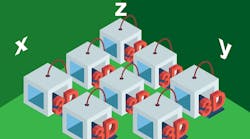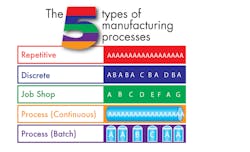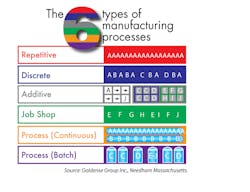For decades there have been five basic types of manufacturing processes. They are distinct. Great design engineers understand the nuances of these processes and tailor their designs accordingly.
There are economic considerations that precede design engineering. Is sales forecasting high volumes? Do we need a continuous production line(s), or will we make the product in discrete lots or batches? All the decades of “familiar decisions” that answered such questions quickly are about to get shaken up. If the choice of manufacturing process type was complicated before, that complexity is about to get multiplied.
The 6th Manufacturing Process: 3D Printing has arrived. Last month (MD July 18), this column cited industry data indicating that rapid prototyping technologies are on the cusp of achieving widespread additive manufacturing capabilities: 875% growth in five years, 30 new equipment manufacturers in the past two years, and companies with more than 100,000 3D-printed units already in the marketplace. Plastics, composites, and now metals give designers a wide range of choices and capabilities in each basic material type. It is this final achievement in metal that will drive a systemic global impact. And, it is already in its early stages. Yes, the part/bed sizes of 3D printers and speed-to-volume still have room to grow. But scale will arrive in the next few years. It’s nearing 40 years since 3D printing was conceived in 1981, but widespread additive manufacturing is now close at hand.
The Original 5 Manufacturing Processes: The first three environments are Repetitive, Discrete, and Job Shop. Taken together, these three environments are a continuum for mechanical, electromechanical, electronic, and software-driven hardware products. At one end, manufacturing is continuous. At the other end, it is highly intermittent. The other two environments are Continuous Process and Batch Process. The 5 Types of Manufacturing Processes (MD Sept. 15) describes each in detail (see figure below).
Source: Goldense Group, Inc., Needham Massachusetts
Comparing 3D Manufacturing and The Original 5: How does one scale volume? Traditionally, more automation was added as one moved from Job Shop toward Repetitive. Engineers would design products to be made by equipment versus by people. The more volume, the less people. For 3D printing, assuming each printer is running full speed, one adds floor space for another printer, and so on. In some ways it harkens back to the pre-automation days of clothing and shoe manufacturers. If volume increased, one would add another person with a sewing machine to make the extra garments. This perspective is grounding. Back to the future? Maybe, but it creates many new and competing trade-off decisions when planning products and their various design and manufacturing alternatives.
Radical Transformation of Design Methods: There are already numerous examples where dozens of parts in an assembly have been replaced by a handful of 3D-printed ones. The implications are enormous. Entire sectors of the supply chain will be affected, such as the fastener industry as assemblies consolidate into fewer parts. In factories, space requirements will change. Sections of the factory that produced intermediate stages of the product will decline, while families of additive equipment will occupy more space. Global portability of operations will increase. Capacity can be quickly located anywhere there is power and telecom. Lastly, industry segments where 3D printing directly turns out finished product will turn into service industries. Digital orders will be transmitted to local UPS, USPS, or Staples stores by the seller and printed locally for you. This has big ramifications for the transportation industry.
Human Effects on Manufacturing Process Choices: Management will have to be vigilant. There is nary an engineer these days who doesn't prefer to iterate a design to success rather than plan a design to success. Iterative design values have become widespread in the past decade, driven by the necessary incrementalism of product design during the Great Recession and the continued maturation of software development and launch techniques. As a result, 3D printing approaches risk being overused. That said, overuse will be a milestone validating that additive manufacturing has arrived.
See the original article containing detailed descriptions of the The 5 Types of Manufacturing Processes in my MD September 2015 column.
See part two of this article on The 6 Types of Manufacturing Processes, and an updated graphic showing the 6 Types, in my MD September 2018 column.



